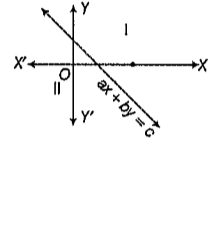The inequality a+ib>c+ is true when
a>c,b>d>0
a>c,b=d=0
a>c,b=d>0
None of these
The correct Answer is:B
To solve the inequality a+ib>c+id for complex numbers, we need to analyze the components of the complex numbers involved.
1. Understanding the Inequality:
The inequality a+ib>c+id implies that we are comparing two complex numbers. Here, a and c are the real parts, while b and d are the imaginary parts of the complex numbers.
2. Separating Real and Imaginary Parts:
We can separate the inequality into its real and imaginary components:
a>candb>d
However, the comparison of imaginary parts does not affect the inequality of complex numbers in the same way it does for real numbers.
3. Conditions for the Inequality:
The inequality a+ib>c+id holds true primarily based on the comparison of the real parts. The imaginary parts do not contribute to the inequality in the same manner as real numbers. Thus, we can conclude:
- The inequality a+ib>c+id is true if and only if:
a>candb=d
4. Conclusion:
Therefore, the inequality a+ib>c+id is true when:
- a>c (the real part of the first complex number is greater than the real part of the second)
- b=d (the imaginary parts are equal)
Final Answer:
The inequality a+ib>c+id is true when a>c and b=d.
The inequality a+ib>c+id implies that we are comparing two complex numbers. Here, a and c are the real parts, while b and d are the imaginary parts of the complex numbers.
We can separate the inequality into its real and imaginary components:
a>candb>d
However, the comparison of imaginary parts does not affect the inequality of complex numbers in the same way it does for real numbers.
The inequality a+ib>c+id holds true primarily based on the comparison of the real parts. The imaginary parts do not contribute to the inequality in the same manner as real numbers. Thus, we can conclude:
- The inequality a+ib>c+id is true if and only if:
a>candb=d
Therefore, the inequality a+ib>c+id is true when:
- a>c (the real part of the first complex number is greater than the real part of the second)
- b=d (the imaginary parts are equal)
The inequality a+ib>c+id is true when a>c and b=d.
Topper's Solved these Questions
- BOOK - MCGROW HILL PUBLICATIONCHAPTER - COMPLEX NUMBERS EXERCISE - EXERCISE LEVEL 155videos
COMPLEX NUMBERS
- BOOK - MCGROW HILL PUBLICATIONCHAPTER - COMPLEX NUMBERS EXERCISE - EXERCISE LEVEL 21videos
COMPLEX NUMBERS
- BOOK - MCGROW HILL PUBLICATIONCHAPTER - COMPLEX NUMBERS EXERCISE - SOLVED EXAMPLES (NUMERICAL ANSWER TYPE QUESTIONS )22videos
COMPLEX NUMBERS
- BOOK - MCGROW HILL PUBLICATIONCHAPTER - CIRCLES AND SYSTEMS OF CIRCLES EXERCISE - QUESTIONS FROM PREVIOUS YEARS. B-ARCHITECTURE ENTRANCE EXAMINATION PAPERS17videos
CIRCLES AND SYSTEMS OF CIRCLES
- BOOK - MCGROW HILL PUBLICATIONCHAPTER - DEFINITE INTEGRALSEXERCISE - Questions from Previous Years. B-Architecture Entrance Examination Papers18videos
DEFINITE INTEGRALS
Similar Questions
Knowledge Check
- Question 1 - Select One
The inequality a+ib<c+ holds if
Aa<c,b<dBa<c,b>dCa>c,b<dDNone of these - Question 2 - Select One
The inequality a+ib<c+ holds if
Aa<c,b<dBa<c,b>dCa>c,b<dDnone of these - Question 3 - Select One
If a+ib=c+, then
Aa2+c2=0Bb2+c2=0Cb2+d2=0Da2+b2=c2+d2
The inequality n!>2n−1 is true
View SolutionThe graph of the inequation 3x+2y>6 does not lie in the 4th quadrant.(True/False)
View SolutionThe graph of the inequality ax+by gt c is represented by shading in the …A…. .Here, A refers to
 View Solution
View SolutionThe inequality 2n<n!n∈Nis true for :
View SolutionThe inequality n!>2n is true for
View Solution

